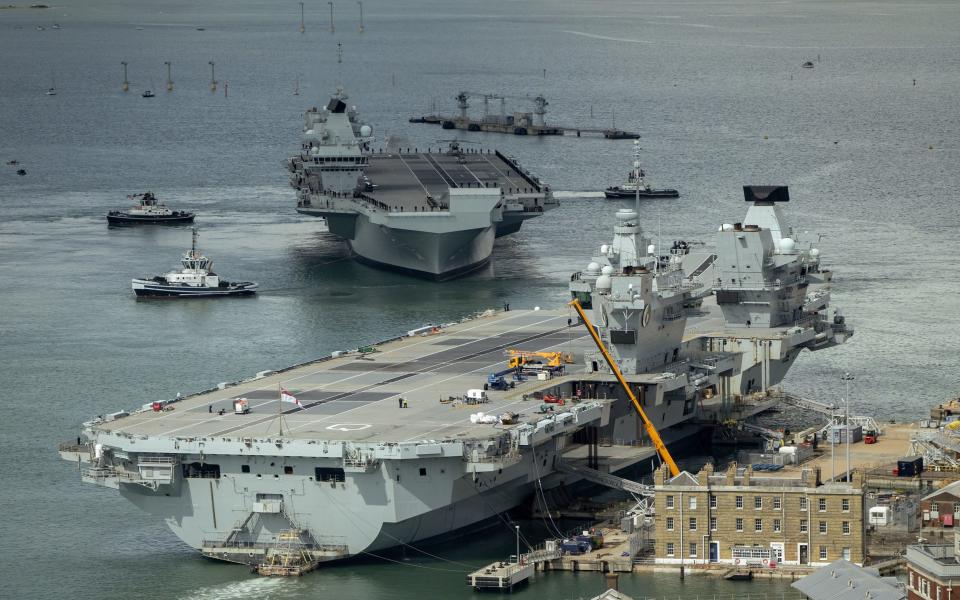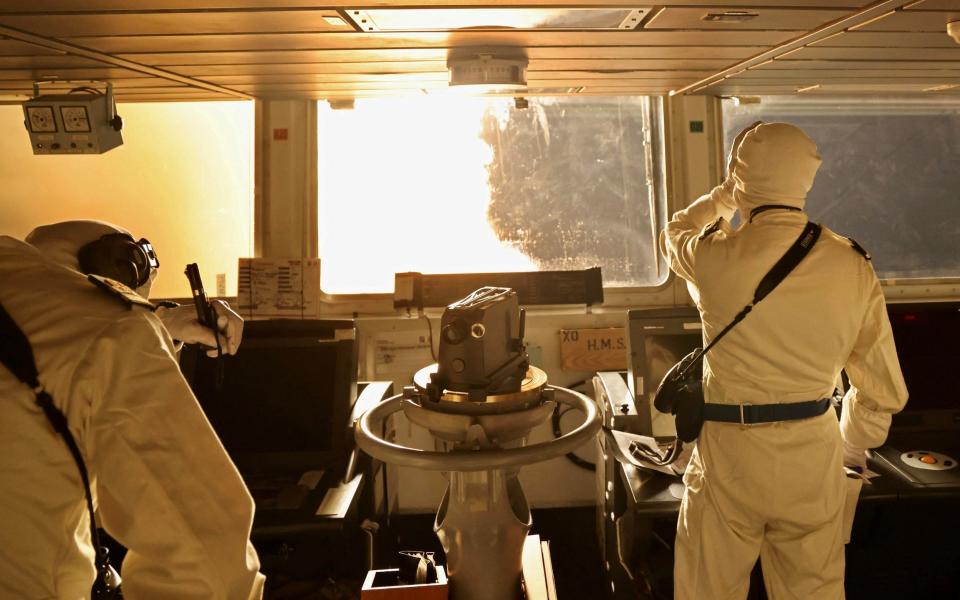We need to talk about aircraft carriers
There’s been a lot of criticism of the Royal Navy’s aircraft carriers lately, some of it from me. Naturally I stand by what I’ve written: but the pile-on has included a lot of suggestions which were misleading, or just plain wrong.
So let’s take a look at the criticisms which are levelled against aircraft carriers.
First, it’s suggested that aircraft carriers in general are obsolete. This is typically said to be a consequence of ballistic anti-ship missiles such as China’s well-known DF-21D. Army officers, air force officers and journalists perennially believe that these are a recent thing, but they aren’t. The first ballistic anti-ship missile, the Soviet R-27K, went into service in 1975. People went on building carriers, including the Russians. China, the nation which knows best just how good the DF-21D is, is building bigger and bigger carriers.
One reason carriers carried on is that ballistic weapons, like other missiles, can be shot down. The US has long had warships capable of ballistic defence, and we plan to upgrade ours to do this too. There’s no mad rush about it, because we aren’t fighting China right now.
Yes, Iran and its Houthi pawns have ballistic missiles, and some of them have seekers which are supposed to let them lock on to a moving ship as they descend, but this is a difficult technical challenge and these are not DF-21Ds. They are much smaller, much less powerful and they have improvised optical guidance rather than proper radar seekers. One of them appears to have struck a US-owned container ship yesterday, but the vessel has reported “no significant damage” and is continuing on its way. These are not “carrier killers”.
This is why a US carrier and a fleet of international warships, many of them without ballistic defence, are happily operating well within the footprint of Houthi ballistics and other weapons in the Red Sea right now. Not to mention quite a lot of merchant shipping, still.
The second major point to bear in mind about any kind of missile you might shoot at a ship is that even if the missile is a proper anti-ship one that can lock on to and hit a moving vessel, you need some idea where the ship is to begin with.
The carrier may be well within the potential range of your missile, but if you haven’t got a decent idea where in that potentially vast area of ocean it is – and where it will have moved to once your missile has got there, which might take some time for a cruise missile – you still can’t usefully take a shot.
Until last week the Houthis had coastal radar stations which could track and target ships some distance out to sea, say thirty miles. They probably don’t have any left now: if they do, they will be detected as soon as they switch on and promptly destroyed, as happened to a Houthi radar which had escaped the initial strikes on Saturday.
Radar in an aircraft is much better than radar down on the surface, as it can see much further – hundreds of miles. A well equipped enemy can send out a radar plane to look for a carrier offshore. But because of the inescapable curvature of the Earth, the carrier’s own radar aircraft will detect the searcher long before it can find the ship. The searching aircraft will run into some carrier fighters shortly after that.
It’s often suggested that carriers can be located by satellites, and this would be relevant if we were talking about Russia or China. However this only works in sharply limited circumstances such as the carrier passing through a strait or chokepoint, and not always then.
The problem is that satellites, being solar powered, can’t have a radar powerful enough to be useful from orbit – and optical sensors only offer a “drinking straw” view. If you know where to look optics can identify a carrier, but knowing where to look is the whole problem. And since satellites in low orbit can’t remain above a point on the surface, you can’t use them to keep a ship under continuous observation.
So in fact, carriers are very difficult to target and they can operate well within enemy missile footprints, as the USS Dwight D Eisenhower is doing right now. Carriers are not obsolete; and no, hypersonic missiles won’t change that.

The next criticism of the Royal Navy’s carriers is that they were staggeringly, unbelievably expensive. British Army officers in particular have a deeply entrenched belief that our carriers are the reason for the Ministry of Defence’s ongoing budgetary “black hole”, a problem which has dogged it for 25 years and shows no sign of going away.
The two ships started costing money in the late noughties, well after the black hole appeared, and total acquisition cost was a bit over £6bn depending what figure you choose. That’s a lot of money, but it’s not a lot of money for an MoD equipment project.
For context, the RAF’s Eurofighter Typhoon jets started costing real money back in the 90s and acquisition costs eventually reached at least £23bn. Deliveries finally completed in 2019. Support costs to 2030 have been estimated at another £13bn.
That isn’t even to mention the huge extra sums spent and to be spent on new bells and whistles for the relatively small number of Typhoons – 90-plus out of 160 delivered – which the RAF can afford to maintain in potentially flyable condition.
More than any other single thing, it was the Eurofighter – not the carriers – which pushed the MoD into its budgetary black hole and is keeping it there today. If Army officers want to hate something, they really ought to consider Typhoon. Another excellent candidate for their ire would be the Voyager tanker aircraft (£11.4bn).

And to be fair it’s not just the RAF and the navy that have expensive equipment problems. The Army’s new Ajax tanks were planned to cost £5.5bn and arrive in 2017. Well over half the money has been spent but not a single working tank has yet been successfully tested. Ajax might be delivered by the end of the decade, more than ten years late. Delays like this cost money, and it will be a miracle if Ajax alone doesn’t wind up costing more than the carriers.
So no, the carriers were not particularly expensive, and they are not the reason for the MoD’s long-running financial paralysis.
Another, completely valid, criticism of the Queen Elizabeth and the Prince of Wales is that they don’t have catapults and arrester wires. This means that they cannot operate fully capable warplanes with full loads of fuel and weapons.
The only plane that can fly from them is the F-35B jump jet, which carries less than other fighters because of its heavy, bulky vertical lift equipment. Given that the Red Sea is barely a hundred miles wide off Yemen, however, it would be pretty mad to suggest that even short-ranged F-35Bs can’t be highly effective against the Houthis from a carrier off the coast.
In any case the navy should not be blamed for the carriers’ lack of catapults. That is the fault of an army man, General Sir David (now Lord) Richards, and a cabal of 12 other senior MoD mandarins, who made sure the ships did not get catapults in a secretive Whitehall campaign a decade ago.
The 13 mandarins claimed that this would save billions, but their figures on the cost of the catapults were deeply unconvincing and in fact their decision is costing the nation vast sums. This is because the jump jet F-35B is much more expensive to buy and fly than the tailhook F-35C – and vastly, madly, wildly more expensive still than the F-18 as used by the US Navy and Tom Cruise, which is still available to buy.
The F-35B’s crippling expense is the reason why we send our carriers to sea with just eight jets aboard vessels designed to carry 36.
It’s a fixable problem: the carriers were designed from the outset so that they could have catapults added at any point in their lives, and they will eventually get them.
Meanwhile eight jets isn’t nothing: and the great thing about jets on a carrier off the coast is that they can patrol over Yemen for long periods of time and strike targets quickly as they appear. The RAF’s land-based Typhoons, by contrast, can only hit a target at four hours’ notice after a longhaul trip from Cyprus – with much air-to-air tanking from those Voyagers that cost almost twice as much as the carriers did – before having to set off back to base pretty much immediately.
In any discussion of cost versus utility today, the £6bn carriers and their F-35Bs (£3+bn for the first 35) trump the £34bn Typhoon and Voyager package absolutely hands down.
The final and most valid criticism of the carriers is that one of them is not in the Red Sea right now. It’s being claimed by various people that this is happening for various reasons.
It’s true that a carrier ought to have a solid stores support ship, and the only one the navy has is unavailable. But the ship could resupply from US support vessels, or simply pop into Jeddah just up the coast.
It’s also true that a carrier needs escort warships, and the navy is indeed short of these. Some people are claiming that sending a carrier to the Red Sea would mean the national nuclear deterrent would be dangerously exposed, or something.
But the fact is, the destroyer HMS Diamond and the frigates Richmond and Lancaster are out there anyway. We’ve sent the escort group: we might as well send the carrier.
My defence sources tell me that the upper levels of the Royal Navy are very keen to get HMS Queen Elizabeth off the wall at Portsmouth and out into the fight: but they have been told not to.
The RAF is involved in this discussion too, as it has control of the partly-naval F-35B carrier fighter force. I would be very surprised if the RAF was not putting forward every reason it can think of why those planes and pilots can’t be sent.
Ultimately, however, it’s a political decision not to send a carrier. And in my opinion, a badly mistaken one.
Lewis Page is former Royal Navy officer

 Yahoo News
Yahoo News 
